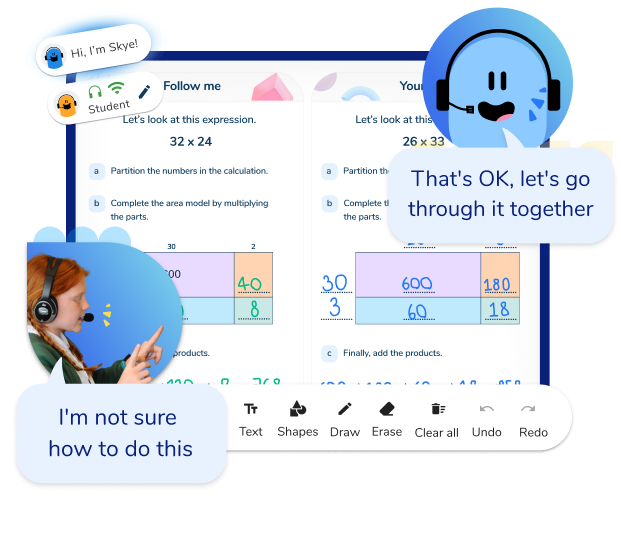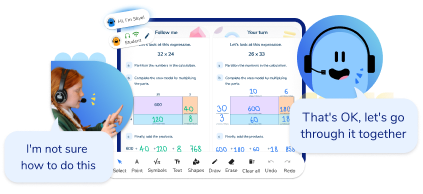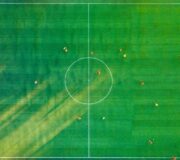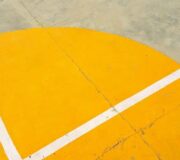What Are 2D Shapes? Explained For Elementary School
Children start learning about 2D shapes from as early as kindergarten, so here is everything you need to know to support them. We cover the two-dimensional shapes children will be taught through elementary school such as squares and triangles to the less familiar polygons. We also look at the properties of 2D shapes that children are expected to know.
Let’s begin with some definitions!
2D Shapes Worksheet
10 questions with answers covering a range of 2nd, 3rd and 4th grade 2D shape topics.
Download Free Now!What are 2D shapes?
2D shapes are shapes with two dimensions, such as width and height. An example of a 2D shape is a rectangle or a circle. 2D shapes are flat and cannot be physically held, because they have no depth; a 2D shape is completely flat.
What does 2D mean?
2D in 2D shapes stands for two-dimensional. We normally talk about dimensions as measurements in a direction. Examples of dimensions include length, width or breadth, depth and height.
The thin plastic math shapes that are sometimes used to represent common 2D shapes are actually 3D because they do have depth to them – even if it’s very small.
Which 2D shapes do children learn about?
In elementary school, children will learn about the following 2D shapes: polygons, regular and irregular shapes.
- A polygon is a 2D shape with straight sides.
- A regular shape has all sides the same length and all interior angles the same size.
- An irregular shape has different lengths of sides and/or interior angles.

Meet Skye, the voice-based AI tutor making math success possible for every student.
Built by teachers and math experts, Skye uses the same pedagogy, curriculum and lesson structure as our traditional tutoring.
But, with more flexibility and a low cost, schools can scale online math tutoring to support every student who needs it.
Watch Skye in actionWhat are the properties of 2D shapes?
The properties of 2D shapes refer to their sides and angles. When we move on to 3D shapes we talk about faces, edges and vertices.
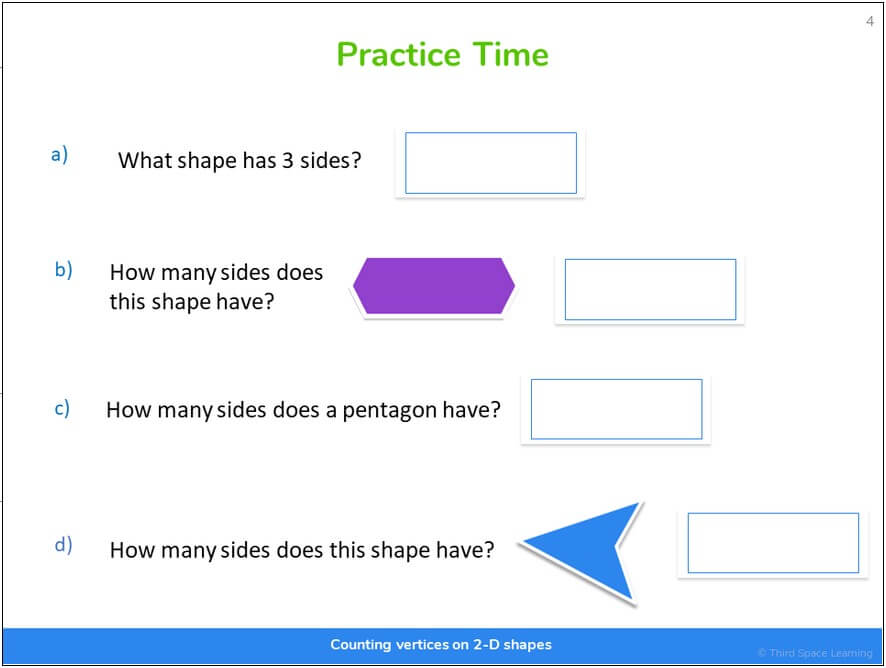
What are the names of the 2D shapes?
These are names of the 2D shapes children will need to know at elementary school:
- Circle
- Triangle
- Square
- Kite
- Rectangle
- Rhombus
- Trapezoid
- Parallelogram
- Pentagon
- Hexagon
- Octagon
- Nonagon
- Decagon
Properties of 2D shapes
As well as the names, children need to know the properties of 2D shapes as listed below and in the printable table.
Circles
- A circle has 1 curved side.
- A semi-circle has 2 sides; 1 curved side and 1 straight side. The full arc is a 180° angle.
Triangles (3-sided shapes)
- An equilateral triangle is a regular triangle and each angle equals 60°.
- A right-angled triangle is any triangle with one right angle.
- A scalene triangle is an irregular triangle. All sides and angles are different.
- An isosceles triangle has two sides and two angles that are the same.
Quadrilaterals (4-sided shapes)
- A square is a regular quadrilateral and each angle equals 90°.
- A kite has two pairs of equal-length sides and the diagonals cross at right-angles.
- A rectangle has two pairs of parallel straight lines and each angle equals 90°.
- A rhombus has two pairs of parallel lines, as well as equal sides and opposite equal angles.
- A trapezoid has one pair of parallel lines.
- A parallelogram has two pairs of parallel lines and opposite equal angles.
Polygons or Regular Polygons
- A pentagon is any shape with 5 sides. The interior angles add up to 540°.
- A hexagon is any shape with 6 sides. The interior angles add up to 720°.
- A heptagon or septagon is any shape with 7 sides. The interior angles add up to 900°.
- An octagon is any shape with 8 sides. The interior angles add up to 1080°.
- A nonagon is any shape with 9 sides. The interior angles add up to 1260°.
- A decagon is any shape with 10 sides. The interior angles add up to 1440°.
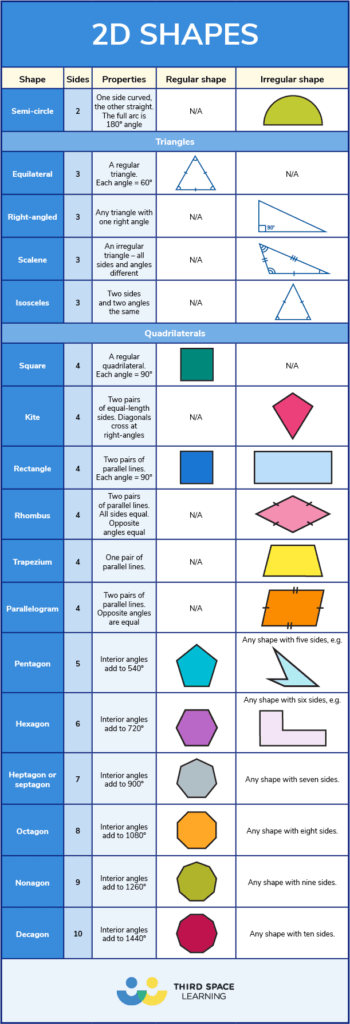
Read more: 2D And 3D Shapes: Properties of Shapes
When do children learn about 2D shapes in elementary school?
Schools following Common Core:
Kindergarten students should be able to:
- Recognize the difference between 2D (“flat”) and 3D shapes (“solid”) and name common 2D and 3D shapes, including: 2D shapes (for example, rectangles (including squares), circles and triangles); 3D shapes [for example, cuboids (including cubes), pyramids and spheres].
- Compare 2D and 3D shapes to describe how they are the same and different, their parts (corners, sides) and other attributes (having sides that are equal).
- Model and/or draw shapes in the world, and compose simple shapes to form larger shapes.
1st grade students should be able to:
- Distinguish between defining attributes (ex: triangles are closed and three-sided) versus non-defining attributes (ex: color, orientation, size).
- Compose 2D (rectangles, squares, trapezoids, triangles, half-circles and quarter-circles) and 3D shapes (cubes, right rectangular prisms, right circular cones, and right circular cylinders)
- Use shapes to create a composite shape, and compose new shapes from the composite shape
2nd grade students should be able to:
- Draw and recognize shapes having specified attributes (ex: a given number of angles, or a given number of faces).Identify triangles, quadrilaterals, pentagons, hexagons, and cubes.
3rd grade students should be able to:
- Understand that shapes in different categories (ex: rhombuses, rectangles, etc) may share attributes (ex: number of sides), and that the shared attributes can define a larger category (ex: quadrilaterals)
- Recognize rhombuses, rectangles, and squares as examples of quadrilaterals, and draw examples of quadrilaterals that do not belong to any of these subcategories.
4th grade students should be able to:
- Identify points, lines, line segments, rays, and angles (right, acute and obtuse), and perpendicular and parallel lines in 2D shapes.
- Classify 2D figures based on the presence or absence of parallel or perpendicular lines.
- Classify 2D figures based on the presence or absence of angels of a specified size.
- Recognize right triangles as a category, and identify right triangles.
- Recognize a line of symmetry for a 2D figure as a line across the figure such that the figure can be folded along the line into matching parts.
- Identify line-symmetric figures and draw lines of symmetry.
5th grade students should be able to:
- Classify 2D figures in a hierarchy based on properties.
- Understand that attributes belonging to a category of 2D figures also belong to all subcategories of that category. (Ex: all rectangles have 4 right angles and squares are rectangles, so all squares have four right angles).
Other schools:
Based on your child’s state and school curriculum, they may be introduced to topics in a different order or in different grade levels. For example, if your child’ school follows the TEKS, your child will be introduced to drawing and measuring angles up to 180 degrees. They will also be expected to solve problems involving angles, including finding the measurement of a missing angle.
How do 2D shapes relate to other areas of math?
When working with fractions, children will often have to shade a fraction of a shape. They will have to relate their understanding of perimeter and area to 2D shapes, and they may be required to reflect or translate 2D shapes on a coordinate grid.
2D shapes questions
1. In a quadrilateral, three angles measure 110, 70 and 20 degrees. How many degrees in the missing angle?
(Answer: 160)
2. Which shape has 2 pairs of parallel sides, 2 acute and 2 obtuse angles and no lines of symmetry?
(Answer: parallelogram)
3. Which shape is the odd one out? Why?
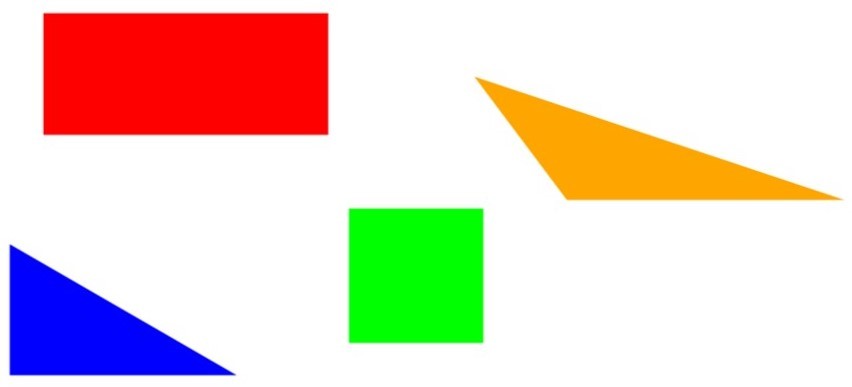
(Answer: The scalene triangle is the odd one out as it is the only shape NOT to have a right angle in it.)
Wondering about how to explain other key math vocabulary to your children? Check out our Math Dictionary For Kids And Parents. You could also check out these similar blogs:
Do you have students who need extra support in math?
Give your students more opportunities to consolidate learning and practice skills through personalized math tutoring with their own dedicated online math tutor.
Each student receives differentiated instruction designed to close their individual learning gaps, and scaffolded learning ensures every student learns at the right pace. Lessons are aligned with your state’s standards and assessments, plus you’ll receive regular reports every step of the way.
Personalized one-on-one math tutoring programs are available for:
– 2nd grade tutoring
– 3rd grade tutoring
– 4th grade tutoring
– 5th grade tutoring
– 6th grade tutoring
– 7th grade tutoring
– 8th grade tutoring
Why not learn more about how it works?
Meet Skye, our AI voice tutor. Built on over a decade of tutoring expertise, Skye uses the same proven pedagogy and curriculum as our traditional tutoring to close learning gaps and accelerate progress. Watch a clip of Skye’s AI math tutoring in action.
The content in this article was originally written by primary school teacher Sophie Bartlett and has since been revised and adapted for US schools by elementary math teacher Christi Kulesza.
